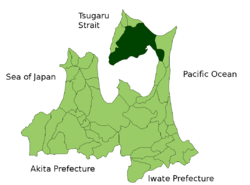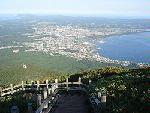この記事へのお問い合わせ
政策推進部市民連携課
〒035-8686
青森県むつ市中央一丁目8-1
電話:0175-22-1111(代表)
広聴連携担当 内線:2151~2154
未来創生担当 内線:2155~2157
消費生活センター 内線:2158~2159
 |
 |
Location of Mutsu in Aomori Prefecture Mutsu City Flag
Mutsu City was originally known as Ominato-Tanabu City, founded in 1959 as a merger of the two towns that created it, Tanabu and Ominato. In 1960, the name was changed to Mutsu, and Mutsu City became the only city with a hiragana name (むつ市)at the time.
In 2005, the neighboring areas of Kawauchi Town, Ohata Town, and Wakinosawa Village were merged into Mutsu City, resulting in the city's current area of 863.79 km² and making Mutsu City the largest municipality in Aomori Prefecture.
| Located in the center of Shimokita Peninsula, Mutsu is border ed by the Tsugaru Strait in the north and Mutsu Bay in the south, giving it a unique topography. In the middle of the city, you will find Mt. Kamafuse (879 m), home to Osore-zan (Mt. Fear, one of the 3 most sacred places in Japan), and from the observation tower near the top of the mountain, you can see the city lights in the shape of a swallowtail butterfly at night. |  |
|
Located in the Shimokita Peninsula in the northern part of Aomori Prefecture, Mutsu City is the northernmost city on Honshu, Japan's main island. City Hall is located at 41°29’N, 141°18’E (*The same latitude as Rome, Italy) |
 |
Mutsu has a cool climate and is covered with snow from mid-December through late March. However, it is not considered a heavy snowfall area.
In summer, a cool wind called the yamase gives Mutsu a moderate climate, making it an easy place to live.
Wildlife
Mutsu City's northern climate makes it a suitable habitat for a distinct number of wildlife.
The Japanese macaque, also known as the snow monkey, is the northernmost-living monkey in the world, and the northernmost-living non-human primate in the world. The species is called nihonzaru in Japanese.
They are designated by Japan as a National Treasure.
Japanese serow (kamoshika) are frequently seen within city limits. They were once hunted to near extinction, but designated as a "Special National Monument" by the government in 1955. Since then, the population has greatly rebounded and they are listed as "least concern".
Swans (hakuchou) can be seen in Mutsu's various bodies of water throughout winter.
Aizu-Wakamatsu City, Fukushima Prefecture, Japan
Port Angeles, Washington, USA
政策推進部市民連携課
〒035-8686
青森県むつ市中央一丁目8-1
電話:0175-22-1111(代表)
広聴連携担当 内線:2151~2154
未来創生担当 内線:2155~2157
消費生活センター 内線:2158~2159
